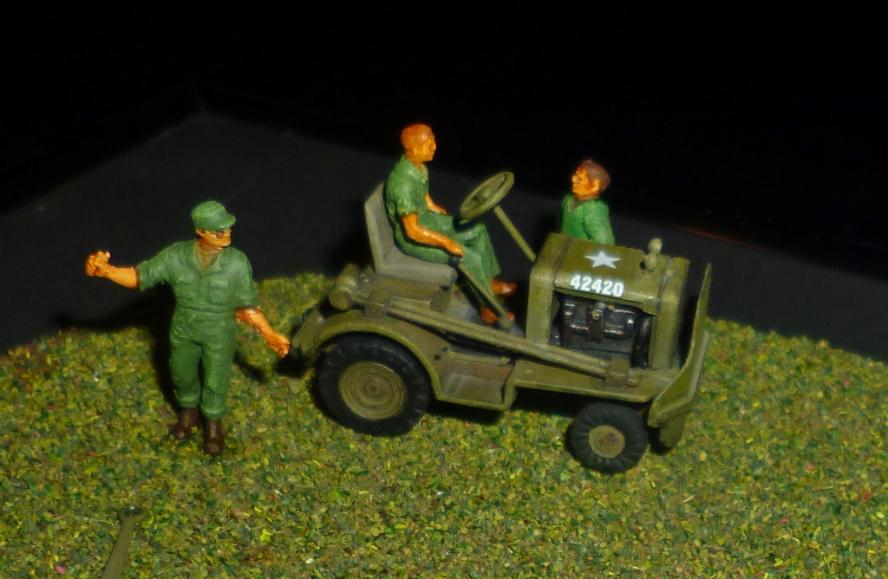
1942 Clarktor 6 MILL-44 Heavy Aircraft Tug.
Used across the American military forces for heavy towing jobs on airfields, Aircraft carriers and Quartermaster depots, the Clartor tugs proved their worth time and again. The Clark Equipment Co. built 3 models of the Clarktor tow tractor between 1940-1963, a "light duty" version, the heavy duty "Mill 44" and a heavy duty "Mill 50".
The smaller version was used for towing small and mid-sized aircraft, small to medium weight goods trains and ground support equipment for aircraft maintenance. The heavy versions took on the big loads and could move up to 90 tons on level ground.
Clark also built 1512 of these versatile tugs for the British under under the requirements of the "Ministry of War Transport", founded on the 1st of May 1941. These tugs are identifiable by their serial numbers which include the letters BH, meaning “British Heavy”.
Visually the three models are very similar and have a wheel base of 59 inches, are 8ft4in long, 5ft5in wide and 4ft8in to the top of the steering wheel. Weighing in at 4,700 lbs (each rear wing is 2in thick and weight half a ton each) you would need something big to tow a Clarktor if it broke down! Chrysler supplied the power in the form T105 or T125 engines for the smaller model or the larger T112 and T116 engines for the “Heavy” models. All are inline 6 cylinder, flat head, side-valve water cooled, petrol engines, the largest of which was the 3,769cc, 63hp T116. Clarktor 6 tugs carried 6 gallons of petrol, had a 3 speed crash gearbox and cold reach up to 15mph top speed.
Eugene B. Clark was
a steel worker when he conceived that the Celfor Drill, and the
metallurgy thereof, made by the George R. Rich Manufacturing Company
was less than adequate. He also believed the company to have poor
production operations and compromised management structures. Clark
offered to correct all the issues but only on condition of being made
an equal partner in the Rich Manufacturing Co.
In 1916 Clark
oversaw the merging of Celfor Tool, the renamed version of Rich
Manufacturing, and the Buchanan Electric Steel Company to form the
Clark Equipment Company. Clark created the Clark Truck/tractor
Company in 1919 to build trucks and tractors. Clark also made a one
off aluminium bodied PCC1000 trolley bus for the Brooklyn and Queens
Transit company in New York this was a prototype of the Presidents
Conference Committee (PCC) series of cars and although Clark won the
contract to build the Trams wheel and trolley sets they did not build
another full tram. This vehicle is currently preserved in the
Kingston trolley Museum in New York.
Through the 1920s and on into the 1960s the Clark Manufacturing company continued to grow and acquire other companies. Thereafter their situation declined and Clark divisions were sold off until Ingersoll Rand purchased what was left of Clark in 1995; then sold on the assets a year later.
As for the Clartor 6 series tugs, many are still at work around the world and others preserved in museums and private collections.












This model came from the Academy WWII Ground Vehicle Set-4, "U.S. Ambulance & Tow Truck" released as kit #13403 in 2005. The set remains on sale and is indeed a great set of kits which also includes a bomb and a bomb trolley.
Both the vehicles in this set are a joy to build and respond well to detailing. The moulding is crisp, the parts fit well and there is a good level of detail straight from the box. Eduard produced a photo-etch set for the kit in 2006 which really brings the models to life.
Built back in 2012 Ian detailed the model with scratch built engine parts made from plastic rod and strip as well as lead and coated wire. The model is brush painted with Humbrol enamels, and Deco-art and citadel acrylic paints. It was always intended to be a part of a larger diorama but this was only finished in December 2016; we think it was worth the wait though.
